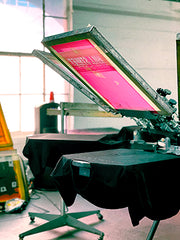
The first people to start screen printing were the Chinese. During the Song Dynasty (960 - 1279). As time wore on other Asian countries adapted the concept to fit their needs. During the 18th century screen printing was introduced to Western Europe. The concept did not catch on immediately. Japanese artists created mesh with human hair to screen print. It wasn’t until silk was imported from Asia to create the screens that it finally started to take off.
During the 17th century France began stretching silk over frames. Factories began creating wallpaper and fabric by screen printing.
In the 1910’s screen printers began experimenting with different photo-reactive chemicals. This work revolutionized the screen printing industry. Photo-imaged stencils were introduced to the industry. Squeegees were also introduced to push/pull ink through the screens.
During the 1930’s artists created the National Serigraph Society. This group differentiated between the use of screen printing for industrial purposes and artistic purposes. Screen printed posters were commonly used in the Works Progress Administration (WPA) to tout the creation of large infrastructure projects in the United States. In 1938 artists began printing on paper and coined the term “serigraphy”.
The 1960s brought about artists such as Andy Warhol and Roy Lichtenstein who made screen printing a very popular technique. Andy Warhol's famous screen prints of Marily Monroe and Campbell's Soup are very famous all over the world. Lichtenstein created screen prints inspired by comic strips. This was the boom time for screen printing. Pop art dominated the art world with screen printing being an integral part of it. The modern rotatable screen printing machine was also introduced in 1967. This screen printing machine was meant to print designs on bowling shirts, but was quickly adopted by t-shirt companies.
Modern day screen printers have the option of creating traditional screen prints or using a method called direct to garment printing (DTG). This method involves using a computer to print an image on a garment using a specially designed printer created for fabrics.




Leave a comment